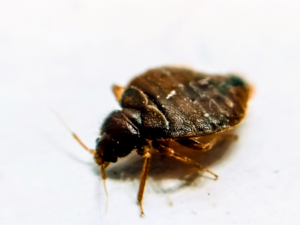Home / Blog / Rodents / Bug vs. Insect: Unveiling the Characteristics That Set Them Apart
Bug vs. Insect: Unveiling the Characteristics That Set Them Apart

Scientifically reviewed by Rachel Maldonado
-Published on January 19, 2024
-Updated on July 31, 2024
Bug vs. Insect: Unveiling the Characteristics That Set Them Apart
Have you ever used the terms “bug” and “insect” interchangeably?
You’re not alone. Many people use these words without realizing that they actually refer to different types of creatures.
While both bugs and insects are part of the arthropod family, they have distinct characteristics that set them apart.
In this post, we’ll break down the difference between a bug vs. insect you need to know about. From their physical features to their metamorphosis process, get ready to discover the detailed distinctions that set bugs and insects apart.
What Are Insects?

Insects are a diverse group of arthropods characterized by their three pairs of jointed legs, three-segmented bodies, and two pairs of wings. They’re found in almost every habitat on Earth, from the deepest oceans to the highest mountain peaks.
There are over 1 million known species of insects, making them the most diverse group of organisms on the planet.
What Are Bugs?
True bugs are a type of insect that belongs to the order Hemiptera. These insects are characterized by their piercing and sucking mouthparts, which they use to feed on the sap or blood of plants and animals.
In most cases, bugs have a distinctive triangular shape that sets them apart from other types of insects.
There are over 80,000 species of bugs found throughout the world, and each one has its own unique characteristics and behavior patterns. Some of the most common types of bugs include stink bugs, which emit a pungent odor to deter predators, and assassin bugs, which ambush and kill other insects.
Despite their unsavory reputation, both insects and bugs play an important role in the ecosystem. Many species are valuable pollinators, helping to ensure the reproduction of plants and crops. Not only that, but many of these creatures are a crucial food source for many other animals, including birds, lizards, and small mammals.
The Difference Between Insects and Bugs
Bugs and insects are often used interchangeably in casual conversation, but in the scientific community, as you now know, there is a clear distinction.
Let’s break down some of those key differences to give you a clearer picture:
Classification
Bugs and insects both belong to the phylum Arthropoda, which means that they are characterized by an exoskeleton, jointed appendages, and a segmented body.
Insects are classified into multiple orders, including Coleoptera (beetles), Lepidoptera (moths and butterflies), Diptera (flies), and Hymenoptera (wasps, bees, and ants).
Bugs, however, belong exclusively to the order Hemiptera, which is divided into two suborders – Heteroptera (true bugs) and Sternorrhyncha (aphids, whiteflies, mealybugs, and scale insects). Therefore, all bugs are insects, but not all insects are bugs.
Morphology
Bugs and insects have a similar body plan, but there are noticeable differences in their morphology.
Bugs have characteristic triangular thoraxes, which distinguish them from other insects. They have two pairs of wings, with the forewings being leathery and the hind wings being membranous.
Often, though not always (for instance, in the case of white flies), the wings are held flat over the body, forming a distinctive X-shape. The triangle shape will, however, always exist just below the head.
Another difference is that bugs have specialized mouthparts called stylets, which are modified mandibles and maxillae that are fused together. These stylets form a rigid, straw-like tube that is used to pierce and suck fluids such as plant sap or blood from other animals.
In contrast, insects that are not true bugs, such as beetles, ants, bees, and flies have mandibles and maxillae that are separate, and they have retractable mouthparts called a proboscis for feeding. Insects have two pairs of wings, but they may be membranous, leathery, or absent entirely.
Life Cycle
Another crucial difference between bugs and insects is their life cycle.
Most insects go through complete metamorphosis, which means that they have distinct egg, larva, pupa, and adult stages.
However, true bugs undergo an incomplete metamorphosis, which means they only have egg, nymph, and adult stages. Bug nymphs resemble small versions of the adult, but they lack fully developed wings and reproductive organs.
As they grow, they molt their exoskeleton several times until they reach adult size. The nymphs and adults of some bugs are wingless, while others have functional wings. Insects that are not true bugs can undergo no metamorphosis, complete and incomplete metamorphosis, depending on the order to which they belong.
Behavior
Bugs and insects have evolved various behavioral adaptations to suit their ecological niches.
For example, bugs have powerful mouthparts that enable them to feed on tough plant tissues or suck blood from vertebrates. Some bugs, such as stink bugs, release foul-smelling chemicals to deter predators, while others, like assassin bugs, ambush their prey by camouflaging themselves.
Ecology
Bugs and insects occupy a wide range of habitats and ecological niches, from soil to air, from freshwater to saltwater, and from tropical to arctic regions.
Many insects, such as butterflies and moths, are important pollinators of flowering plants, while others, such as lady beetles and lacewings, prey on pests and help to control their populations.
However, some bugs, such as bed bugs and kissing bugs, are notorious human pests and vectors of diseases, while others, such as cicadas and lanternflies, cause significant damage to trees and crops.
Similarly, insects that are not bugs also play important roles in the ecosystem.
For example, bees, wasps, and ants are crucial for maintaining the balance of terrestrial ecosystems, while flies and mosquitoes play diverse ecological roles, some of which are beneficial, while others are harmful.
Bug, Insect, Rodent, You Name It – Hawx Will Take Care of It
Now that you know the difference between a bug vs. insect, you might be wondering, does it really matter?
Definitely. Different pests require different treatment methods, and knowing exactly what you’re dealing with is essential for effective pest control. That’s where Hawx comes in.
Our expert pest control technicians are trained to identify and treat a wide variety of pests, whether they’re insects, rodents, or anything in between.
So if you’re dealing with a pest problem, don’t hesitate to contact Hawx and join our satisfied family of customers. We’ll take care of it, whatever “it” may be.
Related Articles
Visit our blog to learn more.
→







